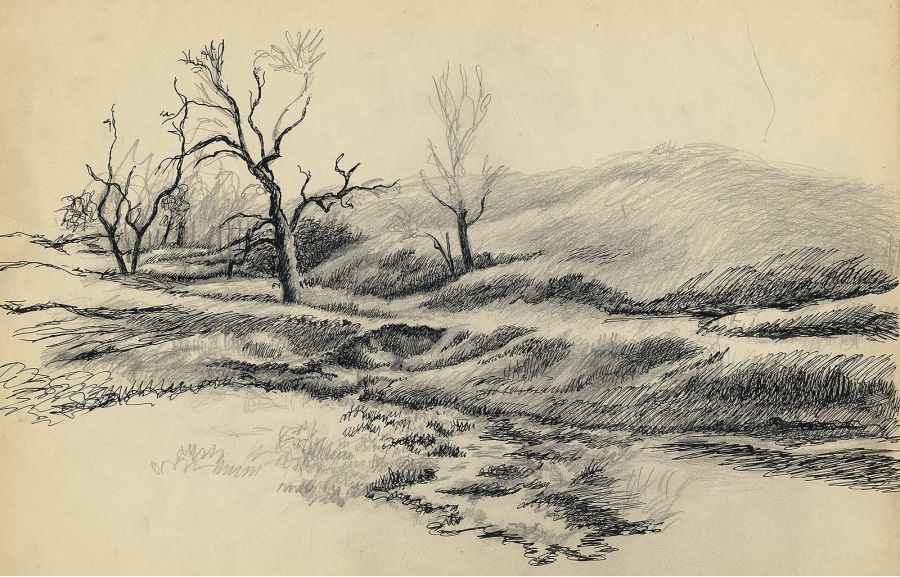ink and pencil drawing
1940
9 x 14
from the artist's sketchbook.
This ink/pencil sketch of a rural landscape was created circa 1941. Nesbitt was always drawing and sketching. This piece is not signed but was taken from the artist's sketch book
The catalog raisonne Jackson Lee Nesbitt / The Graphic Work was compiled by Earl Retif and Ann Salzer and published by Stone and PressJackson Lee Nesbitt, a noted printmaker and painter of the American Scene, dedicated his artistic career to the portrayal of ordinary people going about the business of their lives. Born in McAlester, Oklahoma, on June 16, 1913, Nesbitt created scenes from the Midwest
He attended the Kansas City Art Institute where he learned etching from John deMartelly, attended Ross Braught's painting class, and met his future wife, Elaine Thompson, who was a costume design student. Thomas Hart Benton, who joined the faculty in the fall of 1935, quickly became a close friend and mentor to the younger artist. In 1937 Sheffield Steel contacted deMartelly concerning an etching commission and his teacher suggested him for the job. He was commissioned to create a series of etchings illustrating different phases of the steel industry. The commission launched Nesbitt's career as a professional artist. The commission with Sheffield Steel Corporation provided the financial security that enabled Jack and Elaine Nesbitt to marry on June 1, 1938.
He graduated from the Kansas City Art Institute and working as a freelance artist, Nesbitt augmented his commissioned work with genre scenes of the Midwest. He routinely went with Benton on sketching trips to rural Arkansas. The landscape and people of the Ozarks often appear in the finished work of both artists. Associated American Artists selected one of his etchings, Watering Place, for an edition of 250 prints that were sold through subscription. Having a print published by AAA ensured national distribution. He was awarded the Eames Prize by the Society of American Etchers in 1946, and his work was included in the book American Prize Prints of the Twentieth Century, by Albert Reese. Nesbitt taught etching (1949-1951) at the Kansas City Art Institute.
In 1984 Norman and June Kraeft, (June 1 Gallery) were leading the revival of interest in early-twentieth-century American prints and convinced Nesbitt to return to printmaking. Due to problems with eyesight Nesbitt turned to lithography. From 1988 until 1993, Nesbitt created six lithographs. Five of the prints are composite images based on sketches, people, and memories of Nesbitt's life in the Midwest. Nesbitt's work is found in numerous museums and collections around the nation. His work may be found in Georgia at the Columbus Museum in Columbus and at the Morris Museum of Art in Augusta. Other institutions housing his prints and paintings include the Ackland Art Museum at the University of North Carolina in Chapel Hill; Boston Public Library in Boston, Massachusetts; Columbus Museum of Art in Columbus, Ohio; Library of Congress in Washington, D.C.; Memphis Brooks Museum of Art in Memphis, Tennessee; Muscarelle Museum of Art at the College of William and Mary in Williamsburg, Virginia; and the New Orleans Museum of Art. Nesbitt died near Atlanta, on February 20, 2008.



